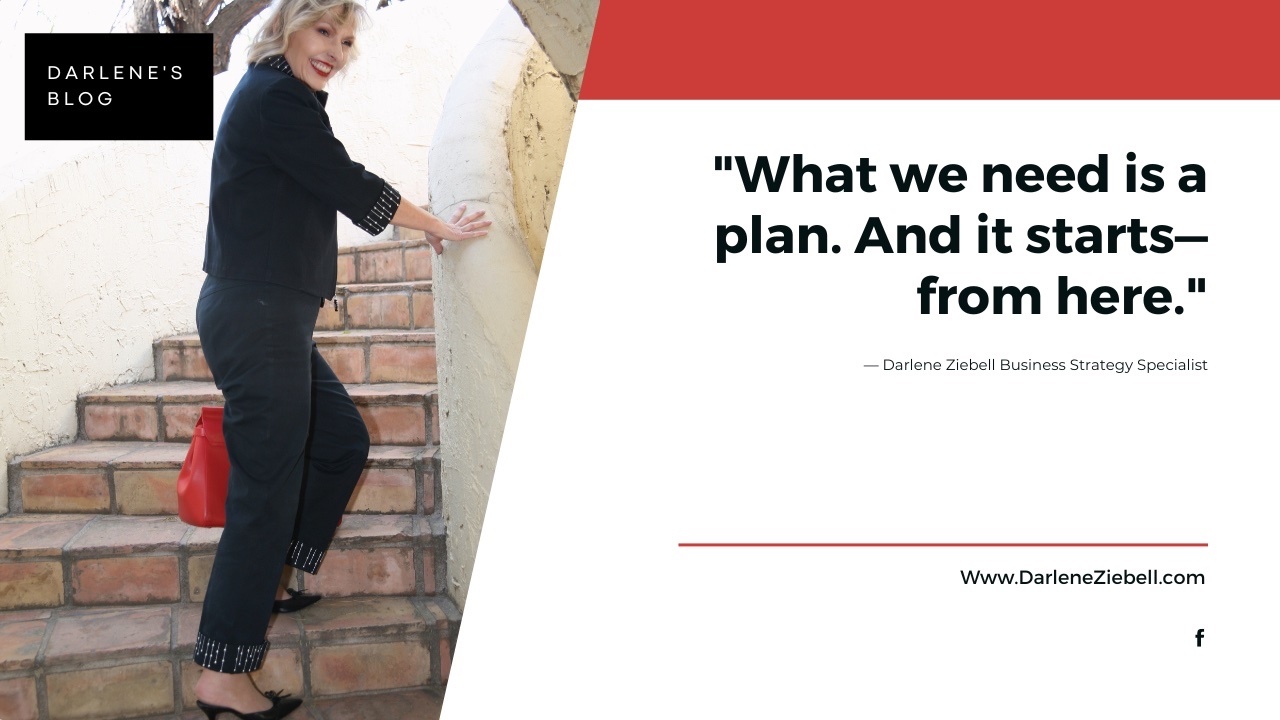What we need is a plan. And it starts—from here.

For many years I’ve been striving to inform business owners about the value of having a business strategy. Many ignore me by telling me they have one. Most think needing more marketing to reach more customers is a business strategy. Well, that is only one step of the ladder to reaching the top to success.
Most business owners are working too hard to achieve their goals. A strategy should identify each step of managing a business and measuring success along the way. It’s like checking the temperature of your car’s engine. Will your car make it? What’s the temperature of your business? Will it make it?
Do you have a business dashboard where lights and bells go off with warning signs that you may need help with? What is on your business dashboard? Do you have one?
The basic definition of a strategy is similar to a GPS. It outlines where you are today, where you plan to go and the route you need to get there. Along the route, your GPS warns you of upcoming traffic problems, roadblocks, speed traps, and many other issues that can delay your trip. Does your business strategy warn you about upcoming business challenges? Why? Because every business has problems. There are no exceptions. What system do you have in place to warn you while you’re busy selling and serving new customers? What are the upcoming business roadblocks you may face?
If you think you already have a strategic plan, verify that it answers all of the following questions. If not, your plan may need some tweaking to build the dashboard required to manage for success.
- Who is the company’s ideal customer?
- Why are these ideal customers?
- How does the business connect to reach these customers?
- What benefits does the customer receive?
- Why does the ideal customer buy from your business versus your competition?
- Are you charging the right price?
- Is your company making a profit on every sale?
- Does your company have a positive cash flow?
- How many people does it take for your business to run? This includes all internal and external people and services required.
- How many different ways does your business bring in sales?
- What is your company’s marketing plan versus sales plans? Do you know the difference?
- What are the potential financial setbacks?
- What are your company’s backup plans for any setbacks?
- How many different functions does it take to manage your business?
- How many people will it take to manage your business as it grows?
- What is your company’s ratio of management versus customers?
- How many sales can your business handle in its current operating plan?
- What is the return on the owner’s original investment?
- What are the key performance indicators used to measure success?
- What will it take to reach your long-term goals? Is your goal 7 or 8-figures?
Here are some examples of key performance indicators. Each of these should be on your business dashboard where bells and lights go off when any of these indicators are not in alignment to reach long-term goals.
- Profitability of each employee or contractor
- Profitability of each sale
- Cash flow projections – number of days sales are outstanding
- How many sales does the company require to break even
- How many sales does the company require to short term goals
- How much money should the company spend in marketing and sales dollars for each customer
- How many are the company’s overall operating costs
- What are the ratios the business uses to measure success on profit and loss statements
Many business owners don’t want to be bothered with lots of details on managing a business. Instead of a solid strategic plan, they use hope to measure success and mainly when there is cash left over after all the bills are paid each month.
In each of my own personal businesses, I spent 50% of my time managing my business keeping an eye on my dashboard, while never taking the other eye off the goal. The other 50% of my time was spent working on acquiring new clients. That’s how I reached 7 and 8 figures in less than two years from my business launch date.
Written by Darlene Ziebell
Copyright 2022 All Rights Reserved
Stay connected with news and updates!
Join our mailing list to receive the latest news and updates from my blog.
Don't worry, your information will not be shared.


